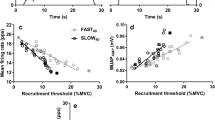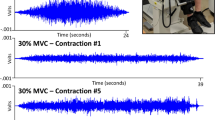Abstract
This study compared fatigue and the spatial distribution of upper trapezius electromyographic (EMG) amplitude during a 6-min constant force shoulder elevation task at 20% of the maximal voluntary contraction force (MVC) (constant force) and during the same task interrupted by brief (2 s) periodic increases in force to 25% MVC every 30 s (variable force). Surface EMG signals were recorded with a 13 × 5 grid of electrodes from the upper trapezius muscle of nine healthy subjects. The centroid (center of activity) of the EMG root mean square map was computed to assess changes over time in the spatial distribution of EMG amplitude. MVC force decreased by (mean ± SD) 9.0 ± 3.9% after the constant force task (P < 0.05) but was unchanged following the variable force contraction. The centroid of EMG amplitude shifted in the cranial direction across the duration of the variable force contraction (P < 0.05) but not during the constant force contraction (shift of 2.9 ± 2.3 mm and 1.4 ± 1.1 mm, respectively). The results demonstrate that periodic increases in force during a sustained contraction enhance the modifications in spatial distribution of upper trapezius EMG amplitude and reduce fatigue compared to a constant force contraction performed at a lower average load. The change in spatial distribution of EMG amplitude over time during a sustained contraction may reflect a mechanism to counteract fatigue during prolonged muscle activity.





Similar content being viewed by others
References
Bigland-Ritchie BR, Johansson R, Lippold OC, Smith S, Woods JJ (1983) Changes in motoneurone firing rates during sustained maximal voluntary contractions. J Physiol 340:335–346
Bigland-Ritchie BR, Dawson NJ, Johansson RS, Lippold OC (1986) Reflex origin for the slowing of motoneurone firing rates in fatigue of human voluntary contractions. J Physiol 379:451–459
Bigland-Ritchie B, Rice CL, Garland SJ, Walsh ML (1995) Task-dependent factors in fatigue of human voluntary contractions. Adv Exp Med Biol 384:361–380
Butler JE, Taylor JL, Gandevia SC (2003) Responses of human motoneurons to corticospinal stimulation during maximal voluntary contractions and ischemia. J Neurosci 23:10224–10230
De Luca CJ, Foley PJ, Erim Z (1996) Motor unit control properties in constant-force isometric contractions. J Neurophysiol 76:1503–1516
Dimitrova NA, Dimitrov GV (2003) Interpretation of EMG changes with fatigue: facts, pitfalls, and fallacies. J Electromyogr Kinesiol 13:13–36
Dimitrova NA, Dimitrov GV, Nikitin OA (2002) Neither high-pass filtering nor mathematical differentiation of the EMG signals can considerably reduce cross-talk. J Electromyogr Kinesiol 12:235–246
Enoka RM, Stuart DG (1992) The neurobiology of muscle fatigue. J Appl Physiol 72:1631–1648
Farina D, Madeleine P, Graven-Nielsen T, Merletti R, Arendt-Nielsen L (2002) Standardising surface electromyogram recordings for assessment of activity and fatigue in the human upper trapezius muscle. Eur J Appl Physiol 86:469–478
Farina D, Leclerc F, Arendt-Nielsen L, Buttelli O, Madeleine P (2007) The change in spatial distribution of upper trapezius muscle activity is correlated to contraction duration. J Electromyogr Kinesiol (in press)
Flodgren GM, Hellstrom FB, Fahlstrom M, Crenshaw AG (2006) Effects of 30 versus 60 min of low-load work on intramuscular lactate, pyruvate, glutamate, prostaglandin E(2) and oxygenation in the trapezius muscle of healthy females. Eur J Appl Physiol 97:557–565
Gandevia SC (2001) Spinal and supraspinal factors in human muscle fatigue. Physiol Rev 81:1725–1789
Garland SJ, Enoka RM, Serrano LP, Robinson GA (1994) Behavior of motor units in human biceps brachii during a submaximal fatiguing contraction. J Appl Physiol 76:2411–2419
Hanson J, Persson A (1971) Changes in the action potential and contraction of isolated frog muscle after repetitive stimulation. Acta Physiol Scand 81:340–348
Holtermann A, Roeleveld K (2006) EMG amplitude distribution changes over the upper trapezius muscle are similar in sustained and ramp contractions. Acta Physiol 186:159–168
Holtermann A, Roeleveld K, Karlsson JS (2005) Inhomogeneities in muscle activation reveal motor unit recruitment. J Electromyogr Kinesiol 15:131–137
Holtermann A, Gronlund C, Stefan Karlsson J, Roeleveld K (2007) Spatial distribution of active muscle fibre characteristics in the upper trapezius muscle and its dependency on contraction level and duration. J Electromyogr Kinesiol (in press)
Hunter SK, Ryan DL, Ortega JD, Enoka RM (2002) Task differences with the same load torque alter the endurance time of submaximal fatiguing contractions in humans. J Neurophysiol 88:3087–3096
Jensen C, Westgaard RH (1995) Functional subdivsion of the upper trapezius muscle during maximal isometric contraction. J Electromyogr Kinesiol 5:227–237
Jensen C, Westgaard RH (1997) Functional subdivision of the upper trapezius muscle during low-level activation. Eur J Appl Physiol 76:335–339
Keenan KG, Farina D, Merletti R, Enoka RM (2006) Influence of motor unit properties on the size of the simulated evoked surface EMG potential. Exp Brain Res 169:37–49
Kossler F, Lange F, Caffier G, Kuchler G (1991) External potassium and action potential propagation in rat fast and slow twitch muscles. Gen Physiol Biophys 10:485–498
Lindstrom L, Magnusson R (1977) Interpretation of myoelectric power spectra: a model and its applications. Proc IEEE 65:653–662
Madeleine P, Leclerc F, Arendt-Nielsen L, Ravier P, Farina D (2006a) Experimental muscle pain changes the spatial distribution of upper trapezius muscle activity during sustained contraction. Clin Neurophysiol 117:2436–2445
Madeleine P, Nie HL, Arendt-Nielsen L (2006b) Dynamic shoulder dynamometry: a way to develop delay onset muscle soreness in shoulder muscles. J Biomech 39:184–188
Maluf KS, Enoka RM (2005) Task failure during fatiguing contractions performed by humans. J Appl Physiol 99:389–396
Mathiassen SE, Moller T, Forsman M (2003) Variability in mechanical exposure within and between individuals performing a highly constrained industrial work task. Ergonomics 46:800–824
McLean L, Goudy N (2004) Neuromuscular response to sustained low-level muscle activation: within- and between-synergist substitution in the triceps surae muscles. Eur J Appl Physiol 91:204–216
McLean L, Tingley M, Scott RN, Rickards J (2000) Myoelectric signal measurement during prolonged computer terminal work. J Electromyogr Kinesiol 10:33–45
Merletti R, Knaflitz M, De Luca CJ (1990) Myoelectric manifestations of fatigue in voluntary and electrically elicited contractions. J Appl Physiol 69:1810–1820
Mork PJ, Westgaard RH (2005) Long-term electromyographic activity in upper trapezius and low back muscles of women with moderate physical activity. J Appl Physiol 99:570–578
Mottram CJ, Jakobi JM, Semmler JG, Enoka RM (2005) Motor unit activity differs with load type during a fatiguing contraction. J Neurophysiol 93:1381–1393
Taylor JL, Todd G, Gandevia SC (2006) Evidence for a supraspinal contribution to human muscle fatigue. Clin Exp Pharmacol Physiol 33:400–405
van Dieën JH, Oude Vrielink HH, Toussaint HM (1993) An investigation into the relevance of the pattern of temporal activation with respect to erector spinae muscle endurance. Eur J Appl Physiol Occup Physiol 66:70–75
Welch PD (1967) Use of fast Fourier transform for estimation of power spectra—a method based on time averaging over short modified periodograms. IEEE Trans Audio Electroacoust 15:70–73
Westad C, Westgaard RH, De Luca CJ (2003) Motor unit recruitment and derecruitment induced by brief increase in contraction amplitude of the human trapezius muscle. J Physiol 552:645–656
Westgaard RH, De Luca CJ (1999) Motor unit substitution in long-duration contractions of the human trapezius muscle. J Neurophysiol 82:501–504
Windhorst U, Hamm TM, Stuart DG (1989) On the function of muscle and reflex partitioning. Behav Brain Sci 12:629–681
Zuylen EJ, Gielen CC, Denier van der Gon JJ (1988) Coordination of inhomogeneous activation of human arm muscles during isometric torques. J Neurophysiol 60:1523–1548
Acknowledgments
The authors are sincerely grateful to Pascal Madeleine (Aalborg University) for the support in the use of the force measurement system. Deborah Falla is supported by the National Health and Medical Research Council of Australia (ID 351678). This study was partly supported by the Danish Technical Research Council (project “Centre for Neuroengineering (CEN)”, contract no. 26-04-0100) and by the European project “Cybernetic Manufacturing Systems” (CyberManS; contract no. 016712) (Dario Farina).
Author information
Authors and Affiliations
Corresponding author
Rights and permissions
About this article
Cite this article
Falla, D., Farina, D. Periodic increases in force during sustained contraction reduce fatigue and facilitate spatial redistribution of trapezius muscle activity. Exp Brain Res 182, 99–107 (2007). https://doi.org/10.1007/s00221-007-0974-4
Received:
Accepted:
Published:
Issue Date:
DOI: https://doi.org/10.1007/s00221-007-0974-4




